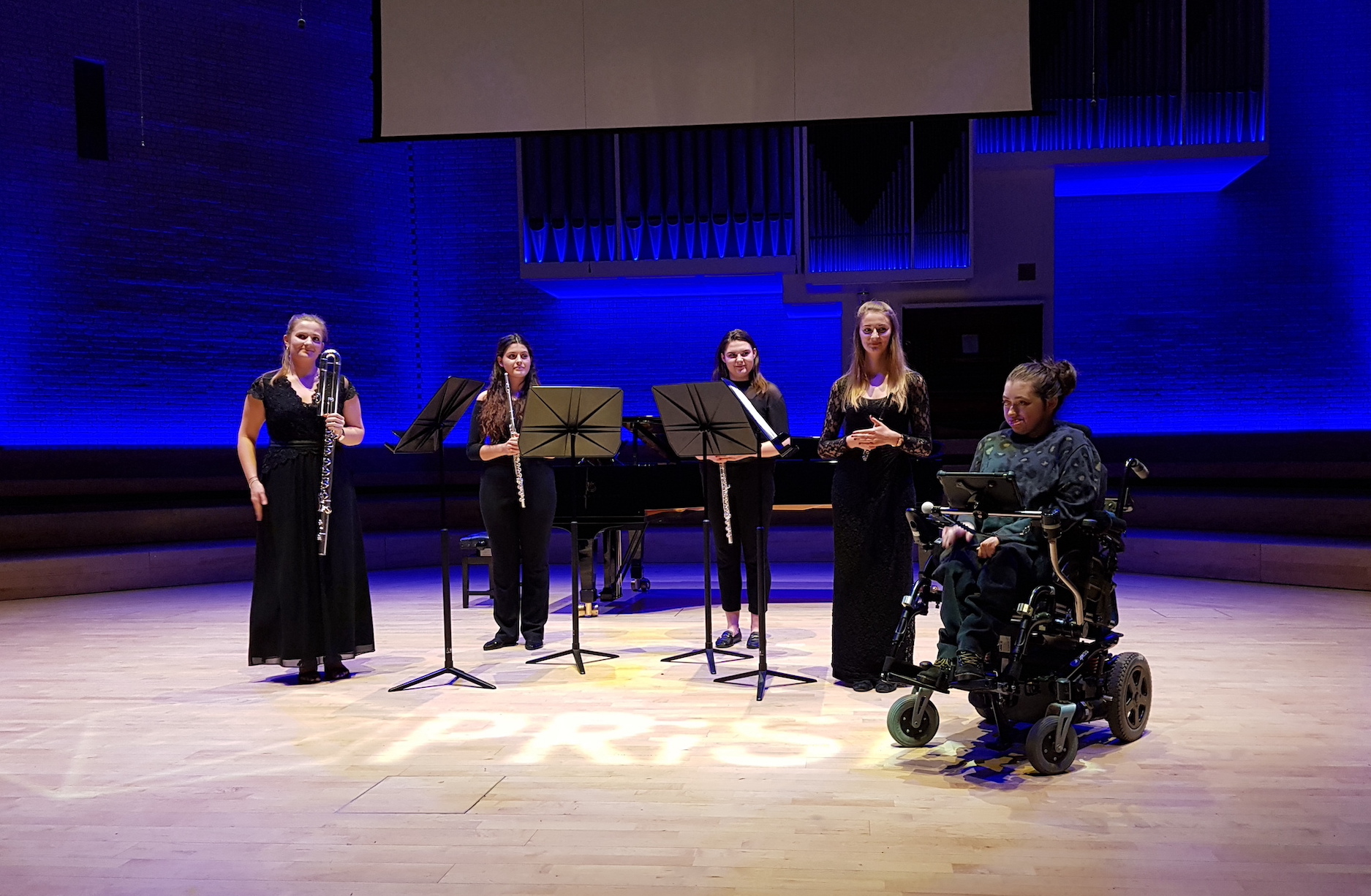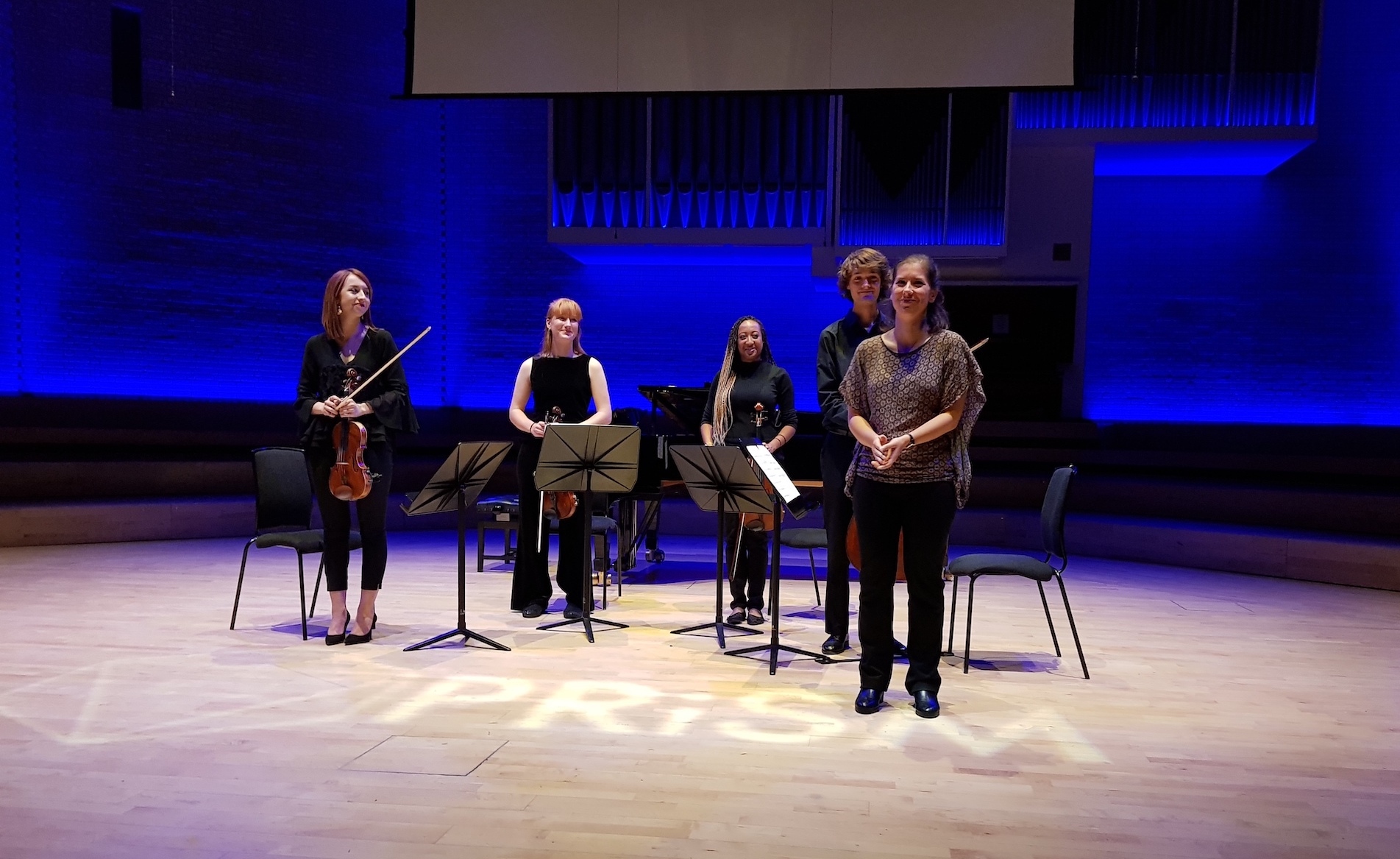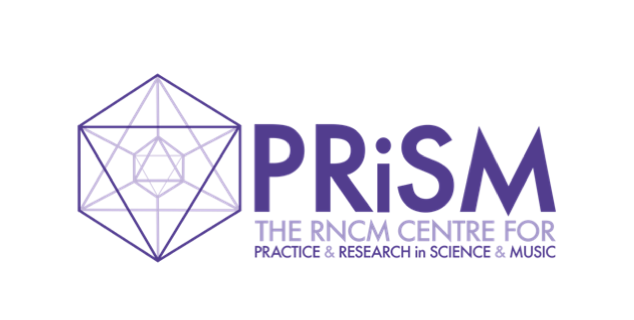The Music of the Primes (23 Oct 18)
Marcus du Sautoy explores the enigmatic prime numbers with RNCM students from the School of Composition
23 October 2018, RNCM Concert Hall

As part of Manchester Science Festival, Professor Marcus du Sautoy, Co-Director PRiSM and Charles Simonyi Professor for the Public Understanding of Science and Professor of Mathematics at the University of Oxford, presented the mathematical story of The Music of the Primes. RNCM students responded in their own individual way to the twists and turns of this unfinished mathematical saga, in four new short commissions for instrumental quartets.
- Device for Putting Out Fires, for soprano and trombone quartet by Stephen Bradshaw
- Zeta, for flute quartet by Lucy Hale
- Primes Eternal, for string quartet by Athanasia Kontou
- Dismantling Factors, for saxophone quartet by Robert Smith
Afterwards, du Sautoy explored how Messiaen’s famous piece The Quartet for the End of Time exploits fascinating mathematical ideas including an extraordinary example of prime numbers to create a sense of never-ending time.
Read on for interviews with Marcus du Sautoy and the composers, and watch the performances.
Introduction by Marcus du Sautoy
“It was a thrilling experience to hear The Music of the Primes as interpreted by the four composers studying at the RNCM. After talking with the students earlier in the year about the mathematics and history of our attempts to understand the enigmatic primes, I was very intrigued to hear what the composers would make of the story. What was so rewarding was to hear such different directions taken by each student.
We had a flute quartet that explored the geometry of the zeta function, a landscape that holds the secret to the primes. A string quartet that captures the never ending nature of these numbers. A quartet for saxophones that enjoyed the indestructability of the primes (that had a child behind me in fits of laughter at the explosions that the saxophones could produce). And a fascinating trombone quartet with soprano singing prime number crossword clues underpinned by an electronic sound track inspired by the connection of the primes to radioactive decay. What an amazing range of ideas! And so wonderfully played by the students enlisted to perform these pieces.

Professor Marcus du Sautoy with William Chadwick (violin) Andrew Mellor (clarinet) Yuuki Bouterey-Ishido (cello) Wyn Chan (piano)
The evening concluded with a spectacular performance by four students of excerpts from Messiaen’s Quartet for the End of Time which uses the primes 17 and 29 to construct the opening movement. I set the students the almost impossible task of playing the opening movement to a film that I made with animator Simon Russel (Quartet for the End of Time) where two cogs at the heart of the film with 17 and 29 teeth click each time the piano plays a chord. It was uncanny how the players who couldn’t see the film were in complete synch with the animation throughout. It was a truly magical moment that helped round off a very special evening. We may not have proved the Riemann Hypothesis but it gave the audience a chance to hear something of the music hiding in the primes.”
Professor Marcus du Sautoy, Co-Director PRiSM and Charles Simonyi Professor for the Public Understanding of Science and Professor of Mathematics
Device for Putting Out Fires by Stephen Bradshaw

Stephen Bradshaw interviewed by Marcus du Sautoy
“I’ve always been interested in science and maths, but I went very much down the arts route and never took either past GCSE. I guess now though, that science interest has translated into what I do as a composer – I’m really interested in electronic music, particularly when it’s performed live. One of the things I’m looking into at the moment is digital instruments that are controlled by physical movement for use in live performance.
There’s an electronic part to the piece: one of the sound materials that I’ve used and processed is a sonification (a process where data are turned into sound) of the Riemann zeta function. It sounds a bit like a tape machine starting up. You can hear it right at the beginning of the piece.
I was fascinated to learn from Marcus that there appears to be some connection with radioactive decay and the distribution of primes – the randomly-distributed short “staccato” notes that the trombones play remind me of radioactive decay – they’re a bit like the clicks of a Geiger counter.
When I started writing the piece I was on holiday in a little farm in the French countryside, which felt absolutely miles away from anything mathematical! I was doing a lot of crosswords (because that’s how exciting my life is) – and I had the idea of constructing the text with prime-numbered crossword clues, which Ann, the soprano, reads out in performance. And primes crop up in other quite arbitrary ways in the piece, for example with sound events being separated by prime-numbered length rests, and structural events happening at prime numbered points in the timeline in seconds.
I got a huge amount out of this project – I didn’t know anything about prime numbers to begin with, and it was an opportunity to learn more and come up with an artistic response. When we first met Marcus, one thing he said that I really liked was that he plays in a football team that plays in prime-numbered shirts. There’s definitely a fun side to primes: once you start thinking about them you notice them everywhere. So my approach to the piece has been quite lighthearted.”
Stephen Bradshaw, RNCM School of Composition MMus Student, 2018
Zeta, for flute quartet by Lucy Hale

Lucy Hale at the premiere of Zeta, with the The Dolce Flute Quartet: Hannah Clark, Grace Callaghan, Emily Revill and Cara Houghton.
“I was a bit hesitant to take on the project because I’ve never really been a maths person, I’ve always thought of myself as more of a humanities and literature person and I come from a family of people who all feel the same. However, in my experience people who love maths seem to really love maths and I was eager to understand why. I wanted to be converted into a maths person!
I was inspired by the concept of the Zeta landscape. I tried to imagine what it would be like if it was a real physical landscape that you might find yourself in. I guess in a way I made it something relatable to my other interests because it became almost like a Narnia or Wonderland-esque fantasy land that you come across a lot in literature.
While I was researching for this piece I looked at images of the Zeta landscape online. Something they all had in common was huge peaks and troughs. I depicted those peaks with sustained chords in all four instruments at the same time which occur sporadically throughout the piece.”
Lucy Hale, RNCM School of Composition MMus Student, 2018
Primes Eternal by Athanasia Kontou

Athanasia Kontou with the Marvolo Quartet: Isabella Baker, Jody Smith, Natalia Senior-Brown and Malcolm Goodare.
“I was very excited to begin working on this project, as I have always liked maths. It was my favourite subject in school and I also enjoyed doing Maths while I was studying for my Bachelor’s degree in Computer Science. Number theory in particular is very interesting to me, and in older pieces of mine I have used algorithms based on prime numbers and Fibonacci numbers.
My piece is inspired by three qualities of the primes that I find fascinating. Firstly, how, even though they are so fundamental in number theory and seemingly simple, they are surrounded by mystery – despite the thousands of years that mathematicians have spent trying to discover their secrets. Secondly, the simple fact that they are infinite, as it is amazing to consider that there are such enormous numbers, with millions of digits that cannot be divided by any other number, and these numbers go on till infinity. Lastly, what inspired me was the beautiful pattern behind them – if the Riemann Hypothesis is true (I would like to believe that it is!)
The central idea in my work is an isorhythm; a series of rhythmical values and notes that repeat themselves. In my isorhythm (as in Olivier Messiaen’s isorhythm in the Quartet For the End of Time) the two series do not always consist of the same number of elements, but two different prime numbers of elements. So even though there is a constant reiteration of the two series, you would have to wait for a long time to hear the exact same pattern repeated twice.
In the middle section, listen out for the “counting primes line” as I’ve called it. This is an ascending line where each new note appears on the 2nd, the 3rd, the 5th beat etc. The line starts from the low cello (pizzicato notes) and passes through all 4 of the instruments to reach the highest register of the first violin.
What you should also listen out for, is the fact that the 4 instruments never play together, as 4 is not a prime, but 2 and 3 are!”
Athanasia Kontou, RNCM School of Composition MMus Student, 2018
Dismantling Factors by Robert Smith

Robert Smith with the Lucida Saxophone Quartet: Kezia Lovick-Jones, Becky Corbett, Martha Cullen and Tasuku Noguchi.
“When writing this piece I wanted to continue to explore the use of pitch generating processes as part of the compositional procedure. With this particular project I saw the opportunity for a large amount of musical data to be produced, from which I could select the material that I liked. This means a balance between ‘extra-musical’ and ‘musical’ as part of the compositional process, which aligned with ‘involuntary’ material production and ‘voluntary’ material selection.
I was particularly drawn to the ‘indestructability’ of prime numbers. This refers to the fact that all numbers can be factorised into primes, but they themselves cannot be factorised. It seemed like such an odd notion that the numbers themselves seemed to posses a physical property (strength), and I thought that this could be not only be used to produced musical material, but also conceptually played with though the piece.
Listen out for a ‘sighing’ motif in the soprano saxophone, which is replied to by a spread chord in the other 3 instruments. At these moments, the upper note of the motif has the frequency of a prime number, and lower note has the frequency of a non-prime. The spread chord in the other instruments is then made up of frequencies that correspond to the factors of each of the non primes. You are therefore hearing a sonic representation of the factorisation process. The material produced by this process is then rearranged, developed and dismantled with increasing intensity as the piece progresses, until all that’s left is noise and a single pitch.”
Robert Smith, RNCM School of Composition MMus Student, 2018


